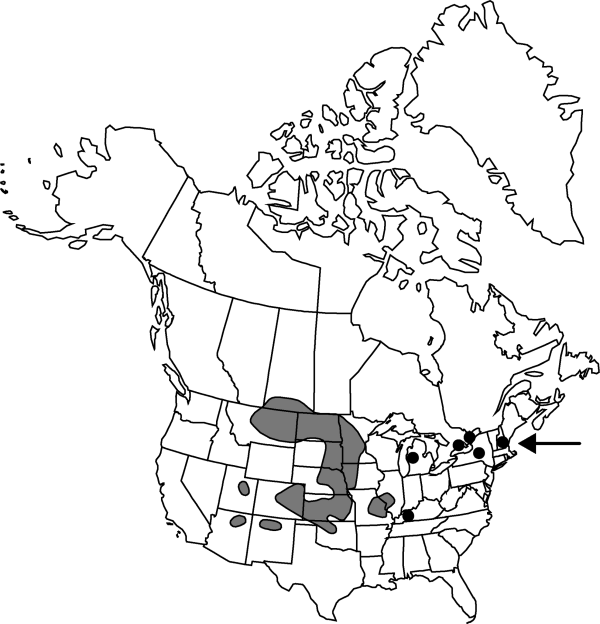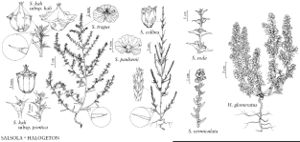Difference between revisions of "Salsola collina"
Ill. Pl., 34. 1803.
FNA>Volume Importer |
imported>Volume Importer |
||
| (6 intermediate revisions by 2 users not shown) | |||
| Line 6: | Line 6: | ||
|place=34. 1803 | |place=34. 1803 | ||
|year=1803 | |year=1803 | ||
| + | }} | ||
| + | |special_status={{Treatment/ID/Special_status | ||
| + | |code=I | ||
| + | |label=Introduced | ||
| + | }}{{Treatment/ID/Special_status | ||
| + | |code=F | ||
| + | |label=Illustrated | ||
}} | }} | ||
|basionyms= | |basionyms= | ||
| Line 23: | Line 30: | ||
|elevation=100-2000 m | |elevation=100-2000 m | ||
|distribution=Ont.;Sask.;Ariz.;Colo.;Iowa;Kans.;Ky.;Mich.;Minn.;Mo.;Mont.;Nebr.;N.H.;N.Mex.;N.Y.;N.Dak.;Okla.;S.Dak.;Utah;Vt.;Eurasia. | |distribution=Ont.;Sask.;Ariz.;Colo.;Iowa;Kans.;Ky.;Mich.;Minn.;Mo.;Mont.;Nebr.;N.H.;N.Mex.;N.Y.;N.Dak.;Okla.;S.Dak.;Utah;Vt.;Eurasia. | ||
| − | |discussion=<p>Salsola collina was reported for the first time for North America from Minnesota by J. W. Moore (1938). It was collected in Kansas in 1923 (R. E. Brooks et al. 1976), but misidentified. Later it was discovered in Colorado, Iowa, and Missouri (V. L. Cory 1948; W. Schapaugh 1958; V. Muhlenbach 1979). Reports of S. collina for Arizona and New York are based on specimens cited by S. Rilke (1999). Its actual distribution seems to be underestimated due to the common and constant confusion with deviant forms of S. tragus. In the future, S. collina may be expected to occur within the major portion of the present range of S. tragus.</p> | + | |introduced=true |
| + | |discussion=<p><i>Salsola collina</i> was reported for the first time for North America from Minnesota by J. W. Moore (1938). It was collected in Kansas in 1923 (R. E. Brooks et al. 1976), but misidentified. Later it was discovered in Colorado, Iowa, and Missouri (V. L. Cory 1948; W. Schapaugh 1958; V. Muhlenbach 1979). Reports of <i>S. collina</i> for Arizona and New York are based on specimens cited by S. Rilke (1999). Its actual distribution seems to be underestimated due to the common and constant confusion with deviant forms of <i>S. tragus</i>. In the future, <i>S. collina</i> may be expected to occur within the major portion of the present range of <i>S. tragus</i>.</p> | ||
|tables= | |tables= | ||
|references= | |references= | ||
| Line 32: | Line 40: | ||
-->{{#Taxon: | -->{{#Taxon: | ||
name=Salsola collina | name=Salsola collina | ||
| − | |||
|authority=Pallas | |authority=Pallas | ||
|rank=species | |rank=species | ||
| Line 47: | Line 54: | ||
|publication title=Ill. Pl., | |publication title=Ill. Pl., | ||
|publication year=1803 | |publication year=1803 | ||
| − | |special status= | + | |special status=Introduced;Illustrated |
| − | |source xml=https:// | + | |source xml=https://bitbucket.org/aafc-mbb/fna-data-curation/src/2e0870ddd59836b60bcf96646a41e87ea5a5943a/coarse_grained_fna_xml/V4/V4_794.xml |
|genus=Salsola | |genus=Salsola | ||
|species=Salsola collina | |species=Salsola collina | ||
Latest revision as of 22:00, 5 November 2020
Herbs, 10–100 cm, sparsely to densely papillose or hispid (rarely subglabrous). Stems erect, rarely ascending, branched above base (occasionally with slender branches near base); branches straight or slightly arcuate. Leaves alternate; blade filiform to narrowly linear, 1–2 mm wide, less than 1 mm wide in herbarium specimens, usually not fleshy, sometimes semi-amplexicaul at base, apex with soft bristle (rarely subspinescent). Inflorescences not interrupted, dense, 1-flowered (rarely 2–3-flowered), often also in axils of proximal leaves and branches, lower ones tightly enclosed in bracts and bracteoles, forming gall-like caducous balls at maturity; bracts alternate, strongly imbricate and appressed at maturity, base not distinctly swollen, apex acuminate into subulate spine. Flowers: bracteoles becoming connate basally and adnate to perianth segments; perianth segments wingless or with narrow, erose wing at maturity, apex acute, weak and flaccid, glabrous; fruiting perianth ca. 2–5 mm diam. 2n = 18.
Phenology: Fruiting summer–fall.
Habitat: Waste places, roadsides, railway areas, cultivated fields, disturbed natural and seminatural plant communities
Elevation: 100-2000 m
Distribution

Introduced; Ont., Sask., Ariz., Colo., Iowa, Kans., Ky., Mich., Minn., Mo., Mont., Nebr., N.H., N.Mex., N.Y., N.Dak., Okla., S.Dak., Utah, Vt., Eurasia.
Discussion
Salsola collina was reported for the first time for North America from Minnesota by J. W. Moore (1938). It was collected in Kansas in 1923 (R. E. Brooks et al. 1976), but misidentified. Later it was discovered in Colorado, Iowa, and Missouri (V. L. Cory 1948; W. Schapaugh 1958; V. Muhlenbach 1979). Reports of S. collina for Arizona and New York are based on specimens cited by S. Rilke (1999). Its actual distribution seems to be underestimated due to the common and constant confusion with deviant forms of S. tragus. In the future, S. collina may be expected to occur within the major portion of the present range of S. tragus.
Selected References
None.
